China yesterday fired several Dongfeng ballistic missiles as it began four days of unprecedented military drills off Taiwan proper following US House of Representatives Speaker Nancy Pelosi’s visit to Taipei the previous day.
On Tuesday, Chinese Minister of Foreign Affairs Wang Yi (王毅) said Beijing would “take all necessary measures” in retaliation should Pelosi visit Taiwan during her Asia tour.
The Chinese People’s Liberation Army (PLA) from 1:56pm to 4pm fired 11 Dongfeng missiles into waters north, east and south of Taiwan proper, the Ministry of National Defense (MND) said.
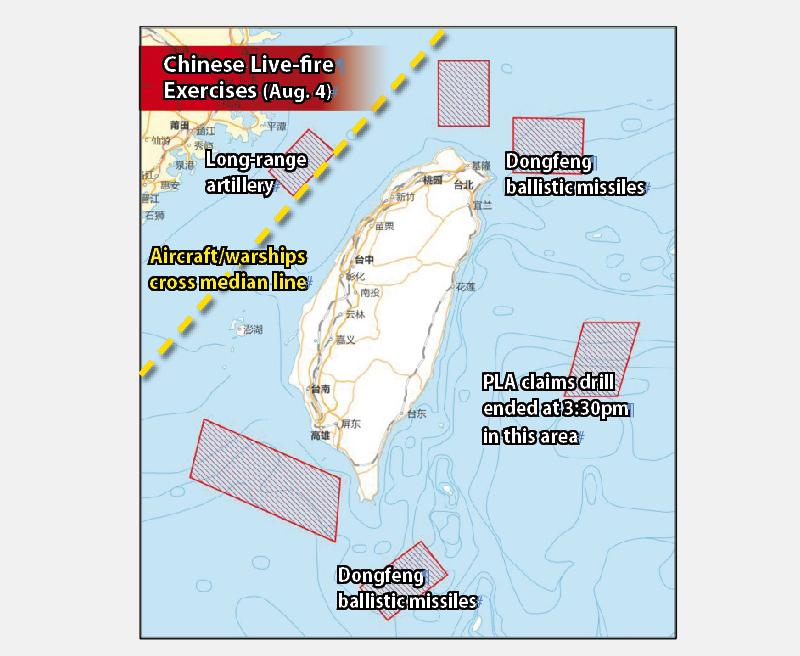
Taiwanese armed forces, using “forward warning and surveillance mechanisms,” monitored the missile tests in real time, activated the country’s defense systems and strengthened combat preparedness, it said.
“The ministry condemns these irrational acts that are damaging to regional peace,” ministry spokesman Major General Sun Li-fang (孫立方) told a news briefing.
China is expected to hold drills in seven areas surrounding Taiwan proper over four days, rather than six areas, as China previously announced, the Maritime and Port Bureau said, adding that the additional area would be to the nation’s east.
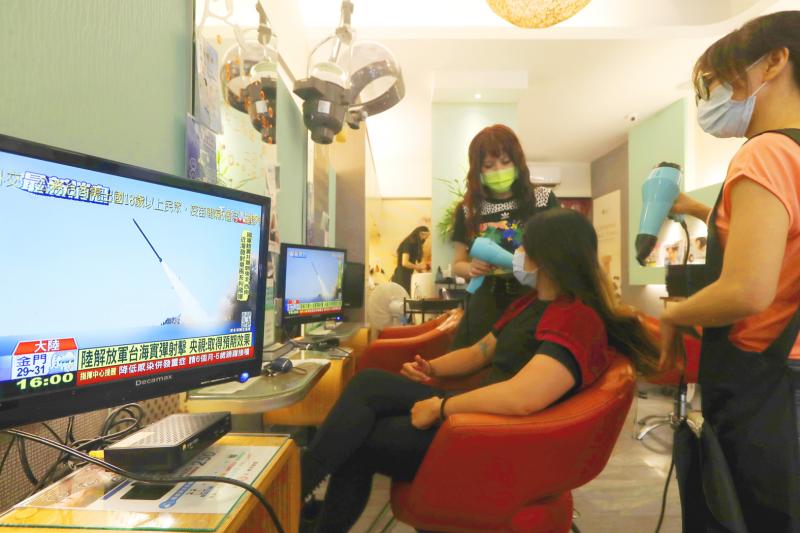
Photo: Chiang Ying-ying, AP
China’s Xinhua news agency reported that the drills were joint operations focused on “blockade, sea target assault, strike on ground targets and airspace control.”
Ma Chen-kun (馬振坤), a professor at National Defense University, said that the drills were aimed at demonstrating the PLA’s ability to deploy precision weapons to cut off Taiwan’s overseas links and facilitate the landing of troops.
The drills would be “more complete” than previous ones, he said.
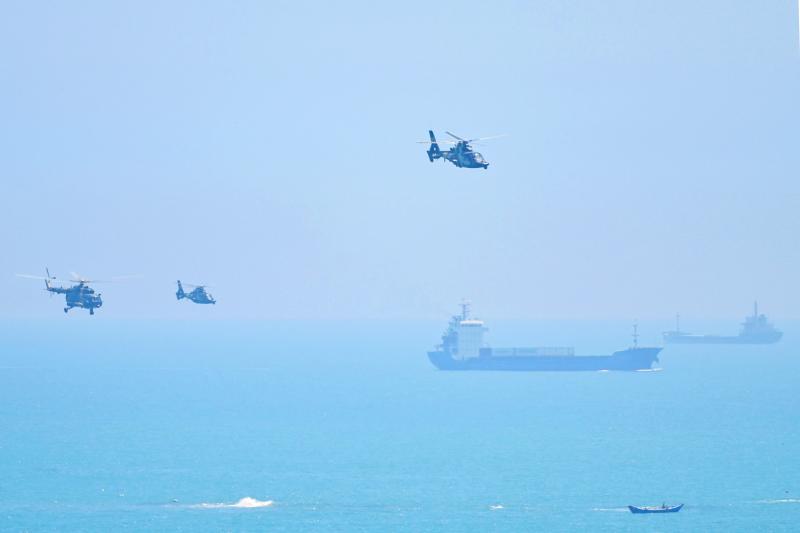
Photo: AFP
“If the PLA actually invades Taiwan in an all-out invasion, the concrete actions it will take, it’s all in this particular exercise,” Ma said. “The main thing is they will cut off Taiwan’s links to the outside world, from their sea, they would suppress the coastal defense firepower.”
The US Navy said that its USS Ronald Reagan aircraft carrier was operating in the Philippine Sea as part of “normal scheduled operations.”
Propaganda footage purportedly filmed during the drills indicated that DF-15B missiles were used, said Su Tzu-yun (蘇紫雲), an analyst at the MND-funded Institute for National Defense and Security Research.
The DF-15B, which entered Chinese service in about 2000, has a range of 600km and a circular error probable of 150m to 200m, meaning half the missiles would fall within that distance of a target, he said.
Predecessors of the DF-15B were fired during the Third Taiwan Strait Crisis in 1995 and 1996, he said.
The Ministry of Foreign Affairs protested the drills, saying they threatened Taiwan’s national security, contributed to rising regional tensions, and caused disruptions in global trade and communications.
“The [foreign] ministry strongly condemns the Chinese imitation of North Korea’s behavior in conducting live-fire missile tests near another country’s sovereign waters and urges the communist regime to exercise self-control,” it said.
The global community should support Taiwan in defending the values of freedom and democracy, the rules-based international order, and a free and open Indo-Pacific region, it said.
Presidential Office spokesman Xavier Chang (張惇涵) decried China’s persistent and deliberate escalation as causing harm to trade and the freedom of navigation.
The office urges reason and self-restraint in Beijing, he said.
President Tsai Ing-wen (蔡英文) is coordinating the government’s response with that of Taiwan’s like-minded regional allies, he said, adding that all necessary and appropriate measures would be taken.
Taiwan would not compromise on the firm defense of its sovereignty, territorial integrity and the alliance of freedom, he said.
Taiwanese and the nation’s political parties should unite in solidarity with Taiwan’s democratic partners to stop China’s irrational and unilateral military actions, he added.
Japan also protested, as five Chinese ballistic missiles appeared to have landed in Japan’s exclusive economic zone (EEZ).
“To have five Chinese missiles fall within Japan’s EEZ like this is a first,” Japanese Minister of Defense Nobuo Kishi told reporters. “We have protested strongly through diplomatic channels.”
The zone stretches 200 nautical miles (370.4km) from the outer limits of Japan’s territorial seas. North Korean missiles have fallen within a different part of Japan’s EEZ in the past, including several earlier this year.
Additional reporting by Aaron Tu, Su Yung-yao and agencies

Seventy percent of middle and elementary schools now conduct English classes entirely in English, the Ministry of Education said, as it encourages schools nationwide to adopt this practice Minister of Education (MOE) Cheng Ying-yao (鄭英耀) is scheduled to present a report on the government’s bilingual education policy to the Legislative Yuan’s Education and Culture Committee today. The report would outline strategies aimed at expanding access to education, reducing regional disparities and improving talent cultivation. Implementation of bilingual education policies has varied across local governments, occasionally drawing public criticism. For example, some schools have required teachers of non-English subjects to pass English proficiency

‘FORM OF PROTEST’: The German Institute Taipei said it was ‘shocked’ to see Nazi symbolism used in connection with political aims as it condemned the incident Sung Chien-liang (宋建樑), who led efforts to recall Democratic Progressive Party (DPP) Legislator Lee Kun-cheng (李坤城), was released on bail of NT$80,000 yesterday amid an outcry over a Nazi armband he wore to questioning the night before. Sung arrived at the New Taipei City District Prosecutors’ Office for questioning in a recall petition forgery case on Tuesday night wearing a red armband bearing a swastika, carrying a copy of Adolf Hitler’s Mein Kampf and giving a Nazi salute. Sung left the building at 1:15am without the armband and apparently covering the book with a coat. This is a serious international scandal and Chinese
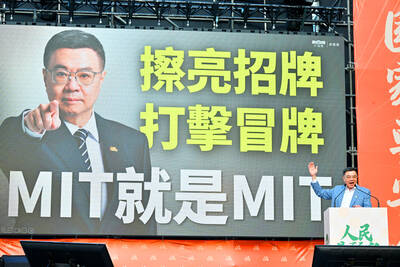
TRADE: The premier pledged safeguards on ‘Made in Taiwan’ labeling, anti-dumping measures and stricter export controls to strengthen its position in trade talks Products labeled “made in Taiwan” must be genuinely made in Taiwan, Premier Cho Jung-tai (卓榮泰) said yesterday, vowing to enforce strict safeguards against “origin laundering” and initiate anti-dumping investigations to prevent China dumping its products in Taiwan. Cho made the remarks in a discussion session with representatives from industries in Kaohsiung. In response to the US government’s recent announcement of “reciprocal” tariffs on its trading partners, President William Lai (賴清德) and Cho last week began a series of consultations with industry leaders nationwide to gather feedback and address concerns. Taiwanese and US officials held a videoconference on Friday evening to discuss the
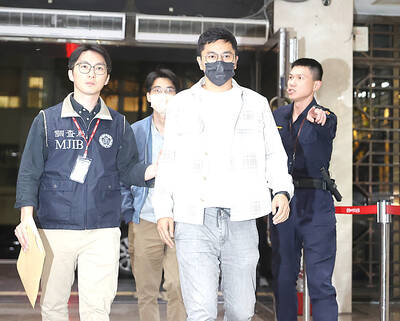
PERSONAL DATA: The implicated KMT members allegedly compiled their petitions by copying names from party lists without the consent of the people concerned Judicial authorities searched six locations yesterday and questioned six people, including one elderly Chinese Nationalist Party (KMT) member and five KMT Youth League associates, about alleged signature forgery and fraud relating to their recall efforts against two Democratic Progressive Party (DPP) legislators. After launching a probe into alleged signature forgery and related fraud in the KMT’s recall effort, prosecutors received a number of complaints, including about one petition that had 1,748 signatures of voters whose family members said they had already passed away, and also voters who said they did not approve the use of their name, Taipei Deputy Chief Prosecutor